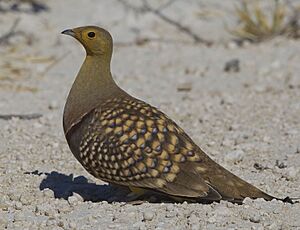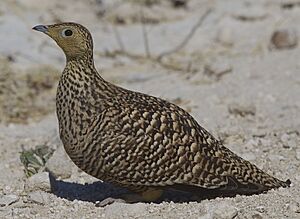Namaqua sandgrouse facts for kids
The Namaqua sandgrouse is a special kind of bird that lives on the ground. It's part of the sandgrouse family. You can find it in dry, desert-like areas of southern Africa.
Quick facts for kids Namaqua sandgrouse |
|
|---|---|
 |
|
| Male | |
 |
|
| Female | |
| Conservation status | |
| Scientific classification | |
| Genus: |
Pterocles
|
| Species: |
namaqua
|
Contents
What Does the Namaqua Sandgrouse Look Like?
The Namaqua sandgrouse is a medium-sized bird. It has a plump body, a small head, and short legs. This bird grows to be about 28 centimeters (11 inches) long.
Male vs. Female Sandgrouse
The male Namaqua sandgrouse is quite colorful. It has an orangish-brown head, throat, and chest. A clear white and dark brown band separates these colors. Its back and wings are mottled brown with many white spots. The male also has two long black feathers sticking out from its tail.
Female and young sandgrouse look a bit different. Their colors help them blend in with their surroundings. They are usually various shades of brown with white spots. It can be tricky to tell them apart from other sandgrouse like the double-banded sandgrouse or Burchell's sandgrouse. These birds live in the same areas.
Where Do Namaqua Sandgrouse Live?
The Namaqua sandgrouse lives in dry parts of southern Africa. You can find them in countries like South Africa, Namibia, Zimbabwe, Botswana, and Angola.
Preferred Homes for Sandgrouse
These birds love deserts and other dry places. To survive, they need seeds, small stones (gravel), and easy access to fresh water. Their homes usually have rough plants and grassy clumps.
How Do Namaqua Sandgrouse Behave?
When it's not breeding season, Namaqua sandgrouse like to be in groups. They gather at watering holes early in the morning. Dozens or even hundreds of birds might meet in one spot. They also spend the night together, gathering about an hour before it gets dark. During the day, they split into smaller groups to find food.
What Do Namaqua Sandgrouse Eat?
Their main food is seeds. But they also eat leaves, flowers, small fruits, insects, and snails. They look for food by digging in loose soil with their beaks. They then flick the soil away to find tasty bits.
Namaqua Sandgrouse Life Cycle and Reproduction
Namaqua sandgrouse can breed at any time of the year. It depends on when it rains. Usually, each pair builds its own nest. Sometimes, several pairs might choose nesting spots close to each other.
Nesting and Eggs
The nest is a simple scrape in the ground. It's lightly lined with dry plant material. The female lays two or three pinkish-grey eggs with brown marks. She lays them over a few days.
Incubation and Chicks
Incubation starts after the last egg is laid. It takes about 22 days for the eggs to hatch. The female sits on the eggs during the day. The male takes a longer shift at night. He starts about two hours before sunset and finishes two hours after sunrise.
The chicks are born ready to move around. They can leave the nest on the day they hatch! The male sandgrouse brings them water. He has special feathers on his chest that can soak up water like a sponge. The chicks grow quickly. They have all their feathers at three weeks old and can fly by six weeks.
Are Namaqua Sandgrouse in Danger?
The Namaqua sandgrouse is common in the areas where it lives. Because of this, it is listed as a species of "Least Concern." This means it is not currently at high risk of disappearing.
Who Preys on Sandgrouse?
Young sandgrouse can be hunted by animals like mongooses. Farmers sometimes kill birds of prey and jackals to protect their sheep. This might lead to more mongooses, which could mean fewer sandgrouse chicks survive. Other birds that hunt Namaqua sandgrouse include the booted eagle, the tawny eagle, the lanner falcon, and the peregrine falcon.


